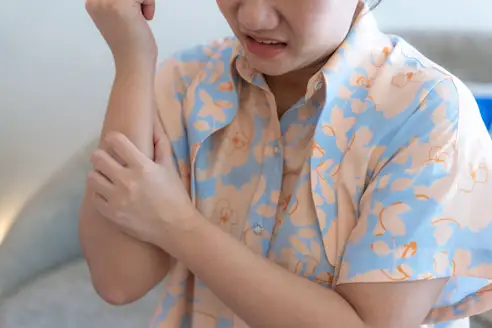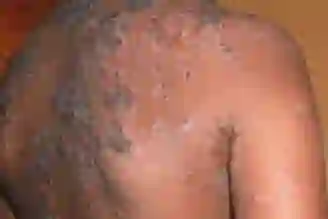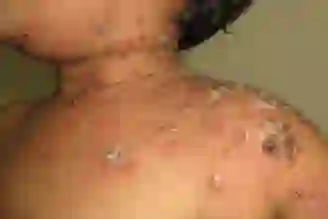Infected Eczema: Pictures, Symptoms and Treatment - Health Central

On its own, eczema is an uncomfortable condition that leaves skin dry, itchy, cracked, and flaky. Infected eczema, however, is an entirely different ballgame. In fact, if infected eczema is left untreated, it can not only be incredibly painful and uncomfortable, but also downright dangerous. To understand infected eczema—including what causes it, symptoms to be aware of, treatment options, and more—we tapped three board-certified dermatologists for their expert insight on the matter. Here, learn everything you need to know about infected eczema and how to protect yourself from it.
What Is Infected Eczema?
Infected eczema is exactly what it sounds like: eczema plagued by infection. According to Marisa Garshick, M.D., an assistant clinical professor of dermatology at Cornell-New York Presbyterian Medical Center in New York City, infected eczema can develop due to the presence of bacteria, fungi, or a virus that invades the skin. "When an infection occurs related to a bacterium, it is referred to as secondary impetiginization," she says. Secondary impetiginization is when bacteria germs not only cause an infection in an eczema cut or scratch but also spread and make the condition even worse.
"And if it's related to a herpes virus, it may be referred to as eczema herpeticum," she adds. Eczema herpeticum is when someone who already has eczema gets the herpes virus on their skin. This virus can make the eczema much worse and can cause sores, blisters, and more itching.
Patricia Oyetakin, M.D., a board-certified dermatologist in Atlanta, GA, says infected eczema is a common complication she sees in eczema patients. "It happens when bacteria, viruses, or fungi take advantage of the defective skin barrier and dysfunctional immune response of the skin," she explains. "The infection then triggers or worsens the already eczematous areas, prolonging the discomfort." Dr. Oyetakin notes that infected eczema is mostly seen in infants and children but can occur at any age.
How to Identify Infected Eczema
If your eczema isn't responding to your usual treatments, Dr. Oyetakin says this is a prime sign that a secondary infection is occurring and needs to be tended to. You may also notice your eczema looks a little different than it normally does. "When eczema is flaring, the skin colors are in the range of pink, red, and purple with whitish scale," says Dr. Oyetakin. "If these areas have other additional colors like yellow, orange, gold, or green this is a big sign that a nasty bug is causing problems and delaying healing."
If the infection is caused by the herpes simplex virus, you may also notice shallow holes or itchy, oozing blisters on the skin. Additionally, eczema that's scabbing or covered in honey-colored crusting means it's most likely infected, says Dr. Garshick. "Eczema that isn't healing or associated with purulent [milky] drainage, worsening redness, tenderness, or warmth are all signs of infection," she adds. And if the infection is severe, you may even develop a fever or swollen lymph nodes.
Symptoms of Infected Eczema
Still unsure what to look for? Refer to this list, compiled from the National Eczema Society, if you're concerned that your eczema might be infected.
Fever
Intense and persistent itching that doesn't respond to usual treatments
Multiple bumps with yellow fluid
Presence of fluid drainage from the affected area
Skin appears blistered, weepy and inflamed
Sudden and persistent burning sensations
Swollen lymph nodes
White or yellow pus
Yellow or orange crusts
What Does Infected Eczema Look Like?
Wondering what infected eczema actually looks like? These photos demonstrate how it can manifest in different areas.



Eczema and Staph Infections
Infected eczema is primarily caused by a type of bacteria known as Staphylococcus aureus—also commonly called "staph" for short, says Michelle Henry, M.D., a clinical instructor of dermatology at Weill Cornell Medical College in New York City. "Staphylococcus bacteria often plays a role in infected eczema, although staph infections can also transpire independently of eczema," she says.
Dr. Henry adds that when eczema becomes infected with staph, it becomes not only itchy and uncomfortable, but painful as well. You may recognize staph-infected eczema by its appearance: It typically presents with pus-filled bumps and/or yellow or honey-toned crusts that sit atop eczema in layers, according to Dr. Oyetakin.
Symptoms of Staph Infections
Staph infections should always be treated as soon as possible, so knowing what to look for is key. In addition to the general signs of infected eczema, staph-infected eczema may include these symptoms, per the Cleveland Clinic:
Crusty, colored layers atop eczema
Eczema symptoms resistant to treatment
Pus-filled blisters emerging over eczema
Sores, crusts, or blisters that don't heal on their own
Spreading red streaks
Swollen, hot, and painful skin bumps or boils
Other Causes of Infected Eczema
"Beyond bacterial infections, additional factors that can contribute to infected eczema include fungal infections, viral agents, or a compromised immune system," says Dr. Henry. "Scratching the itch-prone eczema patches can also introduce bacteria and instigate infection."
Dr. Oyetakin points out that climate, allergies, disruption of the microbiome, environmental factors, and post-inflammation after an eczema flare-up can all put you at risk for infection, too.
Climate
"As seasons change, so does your skin's relationship with eczema," says Dr. Oyetakin. "Dry air and indoor heating during the colder months parch your skin and weaken its barrier, and this vulnerability creates an open invitation for unwanted microbial guests to crash the party."
Allergies
Allergic reactions can exacerbate eczema and lead to cracks and breaks in the skin, making it easier for pathogens to get in and wreak havoc. Common allergens include pet dander, dust mites, and fragrances.
Microbiome Disruption
According to Dr. Oyetakin, the delicate balance of your skin's microbiome can be disrupted by various factors, including genetics, lifestyle, and hygiene practices. "An imbalanced microbiome can encourage harmful microbes to flourish, complicating the eczema equation," she says.
Environmental Factors
Environmental factors—like coming in contact with contaminated surfaces or dirty objects—can be a gateway to infection. Other environmental factors that may lead to infected eczema include smoking and coming in contact with certain industrial chemicals like preservatives and pesticides.
Post-Inflammation from Eczema Flare-Ups
Eczema flare-ups can leave your skin inflamed, damaged, and weakened, which increases your risk for infection. "Even after a flare subsides, the aftermath makes your skin more susceptible to infections, as its natural defense mechanisms struggle to regain their footing," says Dr. Oyetakin.
Treating Infected Eczema
Infected eczema should always be treated quickly so it doesn't worsen and potentially cause systemic problems or other severe complications. To ensure you're addressing an infection the right way, it's important to see a trained dermatologist for treatment options . You will likely need topical or oral antibiotics (or possibly a combination of both) to get infected eczema under control, but according to Dr. Oyetakin there are also some natural remedies (see list below) that can be beneficial at speeding up your healing time and preventing new infections from occurring.
Cortisone cream: If inflammation is at an all-time high, using a mild corticosteroid cream can help calm things down.
Meticulous hygiene: According to Dr. Oyetakin, regular, gentle cleansing of the affected area with mild soap and lukewarm water helps wash away bacterial invaders while supporting the healing process.
Moisturize: Applying a hypoallergenic, fragrance-free moisturizer helps to create a protective shield on the skin, thereby preventing skin from cracking and reducing risk of infection.
Natural remedies: "Nature's pantry holds an arsenal of remedies that can complement a regimen created by your dermatologist," says Dr. Oyetakin. "From the anti-inflammatory prowess of coconut oil to the calming touch of oatmeal baths, these remedies can complement your treatment journey." Natural remedies that Dr. Oyetakin recommends include tea tree oil, Manuka honey, colloidal oatmeal baths, chamomile compresses, coconut oil, aloe vera gel, and diluted apple cider vinegar.
Using bandages: Dressing your eczema with a sterile, non-stick bandage can help prevent further infection while simultaneously soothing the skin affected.
Complications of Infected Eczema
If your infected eczema isn't properly treated, it can cause severe complications that are potentially life-threatening. "Neglected infected eczema can cause a severe skin infection called cellulitis, as well as the formation of abscesses and potentially sepsis, which is a systemic infection," says Dr. Henry. "Timely intervention is imperative to forestall these complications." Additionally, in rare cases, infected eczema caused by the herpes simplex virus can impact the cornea—potentially leading to blindness—as well as the internal organs. "If eczema herpeticum spreads to internal organs such as the brain, lungs, or liver, this can lead to organ failure," warns Dr. Oyetakin. "However, this is extremely rare."
Tips to Prevent Eczema from Getting Infected
Unlike eczema, which you can't prevent, infected eczema is often avoidable if you take the right precautions. "One of the best things you can do to prevent eczema from getting infected is to manage it well and prevent flare-ups," says Dr. Garshick. "This means taking short lukewarm showers only once per day and making sure to moisturize regularly."
On top of that, she advises treating the skin with medication if needed in order to reduce inflammation. These medications include topical steroids, as well as non-steroidal treatments and systemic treatments such as biologics like Dupixent (dupilumab), and JAK inhibitors like Cibinqo (abrocitinib) and Rinvoq (upadacitinib).
Here are some additional ways you can help safeguard your skin from infection, according to the National Eczema Association:
Avoid irritants that can exacerbate eczema and give bacteria a chance to invade.
Educate yourself about the telltale signs of infection—early intervention is everything.
Keep your fingernails clean and short to prevent unintentional skin abrasions.
Practice regular hand washing and good hygiene habits.
Refrain from sharing razors and towels to halt the spread of bacteria.
Shield eczema flares with clothing to dodge bacteria.
Try to avoid scratching—a surface scratch can open the skin and allow infection to enter in.
Use pump dispensers or spoons when applying lotions or moisturizers (instead of tubs) to avoid transfer of bacteria.
The Bottom Line
Eczema can be uncomfortable, but when it gets infected, it becomes painful and dangerous. Infected eczema happens when bacteria, fungi, or viruses invade the skin, making it worse and causing sores, blisters, and itching. To spot infected eczema, look for unusual colors like yellow, orange, or green on your skin, itchy blisters, or notice if it isn't healing or is oozing pus. Infected eczema should be treated quickly to prevent complications like cellulitis or sepsis. To prevent it, manage your eczema well, moisturize regularly, and avoid irritants and scratching.
Comments
Post a Comment